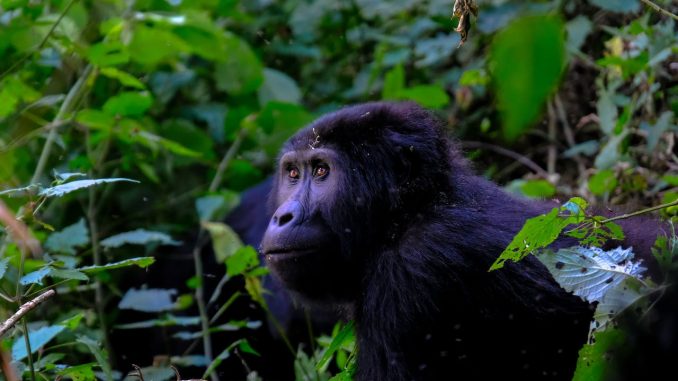
Photo by Francesco Ungaro:
Mountain gorillas are great apes whose population is bouncing hence promoting them from critically endangered list to endangered according to the International Union of the Conservation of Nature (IUCN). If not much conservation efforts from government help and a number of international non-government organization like WWF, IFAW on gorilla protection deep in the rain forest jungles of East Africa. Mountain gorillas were dying at the hands of poachers, habitant loss to agriculture, deforestation, diseases, human conflicts and wars.
The population of mountain gorillas is progressively bouncing back thanks to resilient conservation activities financed by gorilla tourism which has involved the poor communities neighboring the parks to inspire them to become gorilla protectors other than destroyers.
Today there are less than 1200 mountain gorillas in the wild spread over Uganda, Rwanda and DR Congo with about 600 gorillas staying in Bwindi impenetrable national park where tourists can be part of a Uganda gorilla safari while the other half of the gorilla population is located in the Virunga massif region which covers 3 country borders of Rwanda in Volcanoes national park with the largest population, Congo’s Virunga national park having the next large population and the less population in Uganda’s Mgahinga national park
This article explores the rare characteristics of gorillas which you may not know but are worth knowing. We look at gorilla behaviors and social habits, gorilla habitat and ecosystem, diet, and more. Discover top facts about the mountain gorillas with us;
Gorilla Types and habitat
We have two categories of gorillas – the Western and Eastern gorillas and are built for the nature of habitant they live in.
The western species has the Cross River gorillas found and the Western Lowland gorillas found in tropical rain forests of Cameroon, Congo, Gabon, Angola Equatorial Guinea
The Eastern gorilla species further splits into mountain gorillas found in Uganda, Rwanda and Congo and the Eastern lowland gorillas exist in Maiko National Park and Kahuzi-Biega National Park.
Why are gorillas endangered?
In the 1960s, mountain gorillas were listed as the critically endangered species by ICUN and today with efforts put in place to save these species, their status changed to endangered species. At the time, these apes were at the risk of getting extinct in the wild. The Cross-river gorillas are about 300 in number, the western lowlands about 350,000 and the Grauer’s gorillas are about 3800. Gorillas remain among the only species whose population increases at a slow rate.
What makes gorillas endangered first, habitat loss due to human development; death rates due to man-animal conflict, spread of infectious human diseases and more. The habitat loss is as a result of uncontrolled logging, subsistence farming and mining projects. Human-animal conflict has also proven to be the main cause of death of gorillas.
Who are the mountain gorillas?
Mountain gorillas are part of the Eastern gorilla species and occupy only the Virunga region and Bwindi Impenetrable National Park. Several have been habituated, a good reason they are the most tracked. They are scientifically referred to as gorilla beringei beringei, the name they took from Captain Robert von Beringe. The plight of endangered mountain gorillas spread worldwide during the time Dian Fossey conducted research on gorillas in the Virunga areas. She camped in the Virunga and Volcanoes National Park area for 18 years, lived closely with mountain gorillas and campaigned against poaching. To make her research work easier, she established a research center –Karisimbi but journey ended when she was mysteriously murdered.
What is a silverback gorilla
A mature male gorilla is referred to as a silverback and he is the leader of the gorilla family or a successor in the making when the father dies. They can easily be noticed with grey shiny hair on the back contrasting with the black hair. Silverback start grow grey hair at 12 years. Aside from leading the family, he is in charge mating the females. A mature male weighs about 200kg and can stand upright 180cm.
Are gorillas dangerous? How powerful they?
Whereas it is true that gorillas aren’t the giant, ferocious monsters that they were initially believed to be, it is also true that they are powerful creatures and can be dangerous when threatened. A silverback is generally strong, with long canine teeth capable of causing severe injuries. But what is important to note also is that these apes are shy, peaceful and calm except when threatened that they can turn to be aggressive.
Baby gorillas
Infant gorillas are such adorable creatures to locate in the wild. On actual gorilla trek, higher chances are you will find baby gorillas with their mothers and the rest of the family members. Like humans, female gorillas take about 8-9 months gestation period and often give birth to a single infant. They have a low reproduction rate with a mature female becoming fertile at 8 then get baby at 10 years. They give birth after each 4 years.
The oldest gorilla recorded was 40 years. Between 8 and 12 years, males are referred to as black backs and at 12, they grow silver kind of hair on the back and hips, hence the name silverbacks.
What do gorillas feed on?
Gorilla diet composition consists of fruits, leaves, shoots, seeds and vines. They also feed on insects and are said to be vegetarians. The main determinant of gorilla diet is the habitat and may vary from species to species. Mountain gorillas spend most of their time feeding in the montane forested areas. They depend largely on plant leaves, bamboo, gallium, wild celery, thistle, and more.
98% shared human DNA
Mountain gorillas have a lot in common with human sharing up to 98% of their DNA with man. Their genetic make-up makes them our closest relatives in the wild, with several features unique from each individual for instance the teeth, hands and feet with opposable toes and thumbs. Humans are known to have opposable thumbs, with larger brain case as well as S-shaped skeleton instead of gorilla’s bow-shaped vertebral column. Gorillas feature longer arms that they can stretch when climbing on trees.
Intelligent and understand communication
The unique thing that man and gorillas have in common is the skill and intelligence. Like humans, gorillas are capable of using sign language, uproot material, care for young ones.
They make new nests for a night
After the long day of foraging, gorillas make nests on the tree branches. In the night, mothers stay with their babies. During gorilla trekking, gorillas are traced using their nests.
Nose prints identify individual gorillas
Identifying an individual gorilla may not be easy and for mountain gorillas, the significant features that differentiate them are the nose prints. Gorillas in general look similar to each other and can only be differentiated using nose print the mark on the gorilla nose.
Gorillas have names – Kwita Izina
The special gorilla naming ceremony – Kwita Izina is done in Rwanda annually. New born babies are given names during the annual gorilla naming ceremony at Kinigi. The 2023 gorilla naming ceremony was held on 1st September and over 23 baby gorillas were given identity.
They stay in families
Gorillas stay in family groups, each group comprising of over 10 members. In every family group, there is a dominant male and many females. The females and males in the family take responsibility of taking care of infants, playing, hugging and carrying them.




